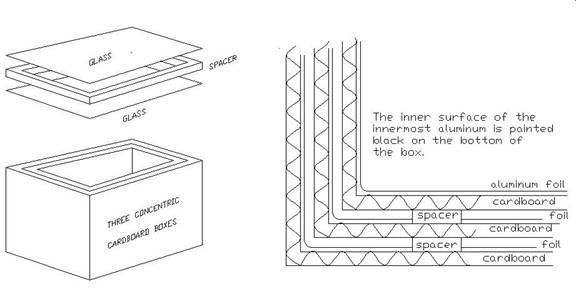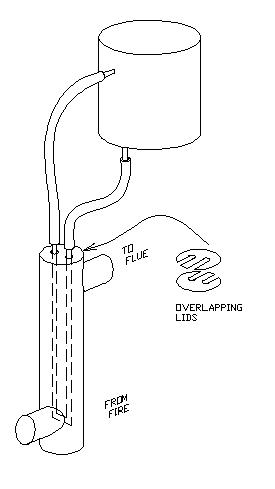Heating Water
Residents of any
sustainable community will heat their water through some renewable
source of energy such as biomass or solar. Even wind can heat water
if it is converted into electricity and fed to a heating element in
the water. The advantage of using wind this way is that electrical
regulation is unnecessary as long as you have water to heat.
It might be practical to
design a hybrid system in which electrical power from wind is used
for lighting, etc., and any excess I used to heat water.
Two
Gallon Solar Water Heater
I
apologize that these water heating projects are also covered (in more
detail in some cases) in the section on energy. My rational however
is that they are quite relevant to this subject as well. I bring this
up to spare you the time in case you have already read, or intend to
read the section on energy.
I
did an experiment for a couple of weeks, where I bathed with no more
than two gallons of scalding water (diluted with cold water as
required of course). The technique was to use warm suds in a
pool about an inch deep in the bottom of the tub.
I
was surprised that I was able to get a very thorough bath and rinse,
and still have hot water left over. The real value of this experiment
was that I demonstrated heating the water in a cardboard box!
The
contraption was basically three layers of foil-lined cardboard, with
a double layer of glass over it. Don’t underestimate the value of
the foil. Although totally lacking in insulating value, shiny
aluminum reflects infrared radiation. Considering that thermal
radiation increases with the fourth power of the absolute
temperature, this loss can be significant unless you enjoy cold baths
– ugh!

The
water was heated in a couple of black-painted gallon milk jugs. They
were resting on a shallow sheet-metal pan also painted black.
With this cheap simple arrangement, water would still be too hot to
use directly for some time after sunset.
When
I returned to a more "civilized" bathing pattern, I began
using it as a solar cooker, and found nothing I couldn't "crock-pot"
during the course of a day. These challenges included beans, and even
baked potatoes. For proper cooking, the food needs to be in a
dark container. The cheap black or dark blue enameled cookware common
to supermarkets and developing nations is ideal.
In
all fairness, I need to add that most of these experiments took place
during the summer time, but the potential for year-round usage is
obviously there.
Another
important detail is that it must either be propped at an angle so the
sun can shine directly into it on its path, or set up some kind of a
reflector arrangement.
Wood
Stove Water Heater
A
simple water heater can be inserted into a flue system to scavenge
energy that would otherwise escape.
A
U-shaped piece of 1/2" copper pipe is suspended in at least a
2’ section of flue. Even though this pipe is exposed to orange-hot
flue gasses, any solder joints will not melt, because the pipe will
be filled with water.
I
connected the ends to a five-gallon can suspended from the rafters in
my shop, with 5/8" automotive heater hose. The connections
to the can were made to pieces of 1/2" copper pipe – one
soldered into the bottom, and the other soldered about half-way up
the side.

I
messed around with a version of this that was connected to more fire
and a 55-gallon drum, but never got around to completing the project;
I did get far enough however, to say with certainty that it can be
done.
To
really be practical of course, any such container would have to be
insulated. Something I didn’t think of until I had how water was a
little faucet in the bottom so that I could actually use the hot
water. Obviously it would need to be refilled any time the water
level fell below the upper tube, or the upper tube will produce only
steam – yet another lesson learned the stupid way. If you aren’t
making stupid mistakes, it’s only because you aren’t doing
anything either stupid or smart.
Solar
Heated Water
I
have had several people enthusiastically tell me that they were able
to heat water simply by pumping it through a coil of black plastic
pipe that was laying out in the sun.
Half-inch
black plastic tubing is one of the cheapest forms of tubing you can
buy. According to my calculations, 250 feet of this stuff would
create a flat doughnut with a diameter of 5-1/2 feet and a hole of
18". This would have an area of 22 square feet. If every thing
was done right, this could increase the temperature of five gallons
of water by about eighty degrees in an hour's time. If there were no
losses at all, you could heat 10 gallons.
The
water can be moved through the tubing by convection, which is based
upon the fact that hot fluid is lighter than cold fluid, and
therefore tends to rise. A convection system of any kind has the
storage above the heat. This explains why the hottest water will be
taken from the upper edge of the collector and fed into the top of
the storage, while the coolest water in the storage will settle to
the bottom, where it is conducted to the center of the collector.
It
is crucial that there is no air in the pipe, and that the water level
in the bucket consistently remains above the entry of upper pipe. A
single tube-diameter bubble however, can keep convection from
happening.
If
you want to actually use this hot water, you're going to need to put
a "T" in the pipe leaving the bottom of the bucket. If you
want more than one shower you may need a bigger bucket -- might I
suggest a half of a 55 gallon drum that was not used for pesticides?
Be careful here, a 55 gallon drum full of water will weight well over
400 lbs, and would be an annoying visitor to entertain in anybody's
shower.
Having
said all that personally, I have had poor results in my minimal
experimenting with solar convection, but I have met people for whom
it did work. I believe the trick is to have a good difference in the
height between the collector and the storage, use large diameter pipe
for an easy flow, and beware of bubbles.
I
did heat a 14’ X 3-1/2’ diameter plastic pool by forcibly pumping
water through coils of plastic on the roof. It was very pleasant to
slip into 95 degree water and a silent world of about 3:00 am.
I
found that a 6 - to - 9 foot diameter coil of plastic can be
difficult to manage. I also had trouble with different flow rates
with coils at different levels on the roof. Thirdly, it took a lot of
pressure to drive a good flow of water through hundreds of feet of
pipe. Another mistake that kind of surprised me was that the black
nylon tie-wraps deteriorated in the sunlight and became brittle after
one season
I
will be changing the system in several ways:
1.
I will be breaking the
system down to multiple units of 4’ diameter tubes and mounting
them on 4’ X 4’ pieces of plywood. This will make them easier to
manage or transport
2.
The tubing will be attached
by wire running through holes in the board, rather than bound by
tie-wraps.
3.
They will be manifolded
together so the flow will be in parallel, rather than in series. This
will reduce the back pressure on the pump.
4.
They will all be mounted at
the same level on the roof. If there are too many modules to make
this practical, they will be mounted in serial pairs – one high,
one low.
As prosperity progresses,
a small well-designed village may provide a centralized hot water
system for the entire village, eliminating the need for hot water
systems at the household level. There would also be a system for the
irrigation of the village food supply. This includes a certain amount
of purification and recycling of available grey-water.
As much as possible, water
should originate from local sources, and be a key factor in carrying
capacity calculations.


